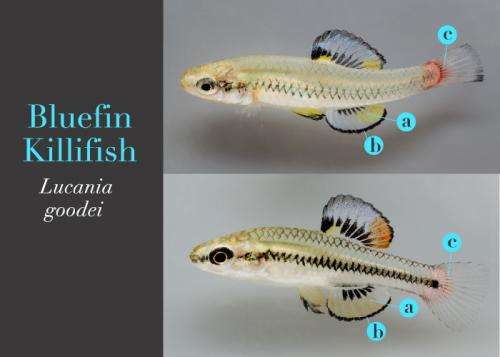Built-in billboards: Male bluefin killifish signal different things with different fins

They help fish swim, but fins also advertise a fish's social standing and health. In a new study, researchers report that for the male bluefin killifish (Lucania goodei), each colorful fin presents its own messages to other fish.
Researchers report their findings in the journal Behavioral Ecology.
They're called "bluefin" killifish, but the first thing University of Illinois animal biology professor Rebecca Fuller noticed while she was snorkeling in a Florida stream was the killifishes' differently colored fins. In addition to having reflective skin, the males sometimes had red, yellow and/or black markings on their anal, caudal (tail) and dorsal fins.
"In some of the males, the anal fin was yellow, and then some of them were red," she said. "And the field guide showed them as blue."
Some of the males had darker black markings on their anal fins than others, and some had bright yellow or orange tailfins.
Fuller immediately wanted to know what was driving the variation.
Previous studies suggested that melanin, the black pigment, is a badge of status among males; those with more prominent melanin markings tend to be more aggressive towards other males. In the new study, Fuller and her former graduate student Ashley Johnson, found that males with heavier melanin outlines on their anal fins dominated: They were more aggressive with other males – driving them off to gain exclusive access to females.
"Melanin is a signal to other males: 'I've been winning in the past and I'm doing well and get out of my way,'" Fuller said.
The red and yellow pigments on the anal fins and the yellow tints on the tailfins have different origins, the researchers found. Carotenoids color the tailfins, but another class of pigments, called pterins, tint the anal fins either yellow or red. Yellow and red pterins are tied to differences in a single gene, Fuller said.
Carotenoids (the same pigments that give carrots and apricots their color) are known antioxidants; they gobble up highly reactive ions or molecules that can damage cells and tissues. Because killifish obtain carotenoids only by eating, researchers hypothesize that a display of color derived from carotenoids signals to potential mates that they are gazing upon a particularly robust, well-fed individual.
In the new study, Fuller and Johnson discovered that richer carotenoid coloration on the tailfin was associated with better body condition, lower parasite infection and good spawning success. This suggests that females respond positively to the brightly pigmented tailfins of potential mates, Fuller said.
Much less is known about pterins, she said. They are associated with immune function and also have antioxidant characteristics, and so also may be a badge of health.
In the new study, the researchers found that the pterin and carotenoid color patterns were independent of one another: Carotenoids colored only the tailfin, while pterins appeared only on the anal fin. Brighter pterin coloration was associated with lower parasite infection and higher spawning success, the researchers found.
"We are finding that communication is complicated in nature and that animals have evolved ways to send different messages to different receivers," Fuller said. "In the case of bluefin killifish, multiple messages are being provided by three distinct pigments that are in three different areas of the body. Both females and males are getting these messages. Males are paying attention to the melanin, most likely, and females are paying attention to these more-colorful fins."
More information: "The meaning of melanin, carotenoid, and pterin pigments in the bluefin killifish, Lucania goodei" beheco.oxfordjournals.org/cont … 0/beheco.aru164.full
Journal information: Behavioral Ecology
Provided by University of Illinois at Urbana-Champaign

















